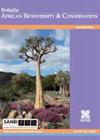Hematologycal and blood biochemistry parameters of captive big-headed amazon river turtles, Peltocephalus dumerilianus (Testudines: Podocnemididae)
IF 0.5
4区 生物学
Q4 PLANT SCIENCES
引用次数: 3
Abstract
The determination of hematological values is used to obtain knowledge about the health conditions of animal species. The bigheaded Amazon River turtles, (Peltocephalus dumerilianus) are considered one of the least known testudine species concerning their biology and health status. Herein, we determined the hematological and plasma biochemical parameters of 17 (eight males and nine females) adult P. dumerilianus to provide reference interval values for clinically healthy individuals. We collected the blood samples by puncturing the femoral vein using long heparinized hypodermic syringes. Sexual dimorphism for individuals was determined by external observation of the shape of the plastron. The average values obtained for the ten hematological and biochemical parameters analyzed were red blood cell count = 0.32 million μL-1; hematocrit = 20.6 %; hemoglobin = 8.5 g dL-1; mean corpuscular volume = 681.6 fL; mean corpuscular hemoglobin = 267.8 pg; mean corpuscular hemoglobin concentration = 41.9 g dL-1; glucose = 80.6 mg dL-1, total protein = 4.1 g dL-1, triglycerides = 388.9 mg dL-1, and total cholesterol = 79.3 mg dL-1. Despite the sexual dimorphism evidenced for the species, there was no significant statistical difference between males and females for both hematological and biochemical parameters analyzed herein. Based on these results, the population is considered healthy, with parameter values coinciding with previously reported reference ranges for testudines species in the region. The results obtained in this study can be used for assessing the health status of other Amazonian turtle populations, especially in actions aimed at cultivation strategies, management, and species conservation.圈养亚马逊河大头龟Peltocephalus dumerilianus血液学和血液生化指标(动物目:足鳖科)
血液学值的测定用于获取有关动物物种健康状况的知识。亚马逊河高头龟(Peltocephalus dumerilianus)被认为是生物和健康状况最不为人所知的龟类之一。本研究测定了17例(雄性8例,雌性9例)成年dumerilianus的血液学和血浆生化指标,为临床健康个体提供参考区间值。我们使用长肝素化皮下注射器穿刺股静脉采集血样。个体的两性二态性是通过外部观察板的形状来确定的。10项血液学生化指标的平均值为:红细胞计数= 0.32万μL-1;红细胞压积= 20.6%;血红蛋白= 8.5 g dL-1;平均红细胞体积= 681.6 fL;平均红细胞血红蛋白= 267.8 pg;红细胞血红蛋白平均浓度= 41.9 g dL-1;葡萄糖= 80.6 mg dL-1,总蛋白= 4.1 g dL-1,甘油三酯= 388.9 mg dL-1,总胆固醇= 79.3 mg dL-1。尽管该物种存在性别二态性,但在血液学和生化参数分析中,雌雄之间没有显著的统计学差异。根据这些结果,该种群被认为是健康的,其参数值与先前报道的该地区家鼠物种的参考范围一致。本研究结果可用于评估其他亚马逊河龟种群的健康状况,特别是在针对培养策略、管理和物种保护的行动中。
本文章由计算机程序翻译,如有差异,请以英文原文为准。
求助全文
约1分钟内获得全文
求助全文
来源期刊

Bothalia
生物-植物科学
CiteScore
1.70
自引率
0.00%
发文量
12
期刊介绍:
Bothalia: African Biodiversity & Conservation is published by AOSIS for the South African National Biodiversity Institute (SANBI) and aims to disseminate knowledge, information and innovative approaches that promote and enhance the wise use and management of biodiversity in order to sustain the systems and species that support and benefit the people of Africa.
The journal was previously published as Bothalia, and had served the South African botanical community since 1921. However the expanded mandate of SANBI necessitated a broader scope for the journal, and in 2014, the subtitle, African Biodiversity & Conservation was added to reflect this change.
 求助内容:
求助内容: 应助结果提醒方式:
应助结果提醒方式:


